The nursing process is a fundamental staple concept to understand in nursing school, both for exams and during clinical with patients and will follow you throughout your entire nursing career.
What are the 5 Steps in the Nursing Process?
A simple way for remembering the five steps in the nursing process is ADPIE — an acronym that stands for:
- Assess
- Diagnose
- Plan
- Implement
- Evaluate
These are the steps of the nursing process, which are chiefly the steps to providing proper care to your patient.
Most importantly, ADPIE is one of the things you’ll be expected to master while in nursing school in order to be successful on the NCLEX and as a future nurse.
The Nursing Process: What Does ADPIE Mean?

ADPIE, or in other words, steps, is a staple in the nursing-care world. It is vital you have a strong foundational understanding of this process to be a successful future nurse. So, we’re here to break it down for you. involves a lot of critical thinking skills, and since many nursing test questions are based on this concept, it’ll make your whole life easier when you understand it for good!
Exploring an example of ADPIE, in the non-nursing world
Interestingly, the funny thing is we actually use the steps of ADPIE in everyday situations without even realizing it. When you see how simple it is to think about, it will be easier to break it down during your exams, and with managing patient care. Let’s take a non-nursing example here to show you what we mean.
Assessment: The first step of the nursing process
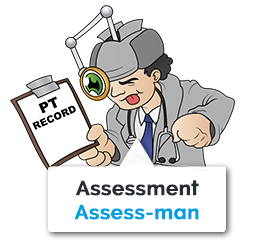
Imagine: you wake up on Monday morning after a late night of caring for patients during your clinical rotation. You have a lot of studying to do for your nursing exam, and you know you’re going to need an extra big cup of coffee. Because it took a little longer to brew, and you’re running 10 minutes late to class, you pour that delicious, warm drink into your thermos, frantically throw it in your backpack, and book it to your first nursing class of the day. When you finally make it to class, you grab your computer out of your bag and open it up, but it won’t turn on. What do you do first?
Well, first, you’re going to assess the situation (the “A” in ADPIE).
Why isn’t the computer turning on? Why is it all wet? Why is your thermos empty? And, why does everything smell like coffee?
At this stage, you’re playing detective and strictly gathering data. Similarly, in nursing, this would be the stage in ADPIE when you first meet your patient — the beginning of the assessment phase during which we collect all the data about the patient, both objective and subjective.
In this case, these would be things like your first impression and vitals. What does the patient look like? Does the patient have pale skin? Is the patient groaning in pain? Are their vitals stable? Is their breathing labored? Is the patient angry, scared, confused, or delirious? When taking the health history, do you notice a history of heart problems? What kind of medication is the patient taking?
These are all observations and data collection to determine the health of the patient when assessing. As the first step in the process, gathering all this information will allow you to proceed with the next step: your nursing diagnosis.
Nursing Diagnosis: The second step of the nursing process
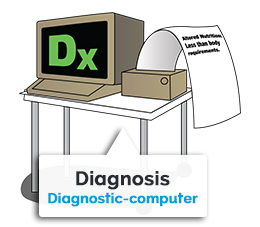
The “D” in ADPIE stands for diagnosis, bringing us to our next step in the nursing process. After gathering the data from the assessment phase, we need to diagnose the patient.
Going back to our example: “Well,” you say to yourself, “it seems to me from all the evidence here, my coffee must’ve leaked out of my thermos onto my computer, and therefore my computer is not working because it has gotten soaked with coffee!” Good deduction, detective!
Forming a nursing diagnosis based on guidance from NANDA-I
Developing a nursing diagnosis means taking into account the subjective data and considering it alongside the objective data you discovered during your conversations with your patient. In our clinical assessment, when we’re dealing with a patient, we make a nursing diagnosis in which we identify actual or potential medical and health risks.
Simply, the nursing diagnosis is the clinical judgment that allows nurses to develop a plan for the care of the patient. This four-step process, developed by NANDA International, Inc. (the principal organization for defining, distributing, and integrating standardized nursing diagnoses worldwide), should be prioritized based on Maslow’s hierarchy of needs. This diagnosis is key to the next step in the process: making a nursing care plan.
A nursing diagnosis differs from a medical diagnosis, made only by a physician. Nursing diagnosis can be mental, spiritual, psychosocial, physical, or a combination of all these factors. It focuses on the overall care of the patient while the medical diagnosis involves only the medical aspect of the patient’s condition.
The official definition of the nursing diagnosis from NANDA-I:
“Nursing diagnosis is a clinical judgment about individual, family, or community responses to actual or potential health problems/life processes. A nursing diagnosis provides the basis for selection of nursing interventions to achieve outcomes for which the nurse is accountable.”
The four categories of nursing diagnoses provided by the NANDA-I system
Type 1: Actual (Problem-Focused)
Problem-focused nursing diagnoses are typically based on the signs and symptoms present in the patient at the time of assessment. Problem-focused diagnoses are the most common nursing diagnoses and the easiest to identify.
Type 2: Risk
The risk nursing diagnosis requires clinical reasoning and nursing judgment and applies when risk factors require intervention from the healthcare team before a problem develops.
Type 3: Health Promotion
A health promotion nursing diagnosis helps to improve the overall well-being of an individual, family, or community. Examples of a health promotion nursing diagnosis can include public health programs like smoking cessation classes or stress management techniques.
Type 4: Syndrome
A syndrome diagnosis refers to a cluster of nursing diagnoses that occur in a pattern or can all be addressed through the same or similar nursing interventions. An example of a syndrome nursing diagnosis could include syndromes like rape trauma syndrome or post-traumatic stress disorder.
Explaining the nursing diagnosis using Taxonomy II
In collaboration with the National Library of Medicine (NLM), NANDA-I codes nursing diagnosis according to seven axes: diagnostic concept, time, unit of care, age, health status, descriptor, and topology. In addition, diagnoses are listed alphabetically by their concept. Taxonomy II has three levels: domains (13), classes (47), and nursing diagnoses.
- Domain 1 – Health Promotion
- Health Awareness
- Health Management
- Domain 2 – Nutrition
- Ingestion
- Digestion
- Absorption
- Metabolism
- Hydration
- Domain 3 – Elimination/Exchange
- Urinary Function
- Gastrointestinal Function
- Integumentary Function
- Respiratory Function
- Domain 4 – Activity/Rest
- Sleep/Rest
- Activity/Exercise
- Energy Balance
- Cardiovascular-Pulmonary Responses
- Self Care
- Domain 5 – Perception/Cognition
- Attention
- Orientation
- Sensation/Perception
- Cognition
- Communication
- Domain 6 – Self-Perception
- Self-concept
- Self-esteem
- Body image
- Domain 7 – Role Relationship
- Caregiving Roles
- Family Relationships
- Role Performance
- Domain 8 – Sexuality
- Sexual Identity
- Sexual Function
- Reproduction
- Domain 9 – Coping/Stress Tolerance
- Post-trauma Responses
- Coping Response
- Neuro-Behavioral Stress
- Domain 10 – Life Principles
- Values
- Beliefs
- Value/Belief Action Congruence
- Domain 11 – Safety/Protection
- Infection
- Physical Injury
- Violence
- Environmental Hazards
- Defensive Processes
- Thermoregulation
- Domain 12 – Comfort
- Physical Comfort
- Environmental Comfort
- Social Comfort
- Domain 13 – Growth/Development
- Growth
- Development
How to write the nursing diagnosis
Effective and efficient communication of the nursing diagnosis to the healthcare team is critical for patient care. The nursing diagnosis can help the physician during their assessment and diagnosis phase, in addition to helping to roadmap the patient’s treatment plan.
Writing the nursing diagnosis includes three parts: the problem statement, the etiology, and the defining characteristics.
- Problem statement – Explains the patient’s current health problem and the nursing interventions needed to care for the patient.
- Etiology – Communicates related factors and describes the possible reasons for the problem or the conditions in which it developed. These related factors guide the appropriate nursing interventions.
- Defining characteristics – Using signs and symptoms allows for applying a specific diagnostic label. NOTE: For a risk nursing diagnosis, describe the risk factors in lieu of a sign or symptom (for example patient reports smoking 12 cigarettes daily). These risk factors increase the patient’s vulnerability to health problems, but the patient may not be experiencing an actual problem yet.
Plan: The third step of the nursing process
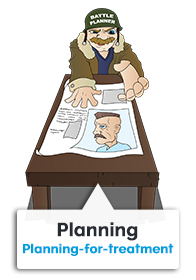
Now that we’ve assessed and diagnosed the patent, this brings us to “P” in the ADPIE acronym (the third step of the nursing process), which stands for planning.
Back to our computer example: When you look at your computer and have figured out the cause, you now have to make a quick plan. What are you going to do to fix the problem? You decide you need to run to get this computer fixed by a professional. “Let’s see,” you think, “I have to call to see if the store is open, make an appointment, find out if your computer was backed up, leave school, take the bus to 33rd Street, walk two blocks…”
When we apply this same process to nursing and patient care, we make a plan based on the assessment and nursing diagnosis of our patient(s). You would then set SMART goals for achieving this plan.
What are SMART goals? SMART is an acronym that stands for specific, measurable, attainable, realistic, and timely. In the planning phase of the nursing process, you’ll set SMART short-and long-term goals for the patient, and communicate these to the team.
From here, we can move on to the implementation phase of the process.
Implement: The fourth step of the nursing process
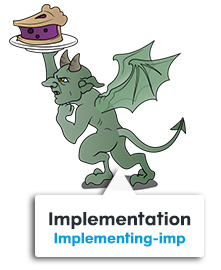
Next comes the “I” in ADPIE; the implementation phase of the nursing process. First, let’s circle back to the computer example.
Implementation is the action part of your plan. This is the phase during which you actually get up and bolt to the computer store to fix this, fast!
Notice here the difference between the planning stage and the implementation stage. In the planning stage, you are simply forming the plan. No action has begun yet. The implementation stage, however, is where you act on that specific plan. Or, intervening.
Similarly, when we take this back into nursing and patient care, this is where we implement our plan for our patient(s). As the action portion of the process, this is where our plans are carried out.
Implementation is the step in which we intervene to help the patient. Implementation can include physically doing something, like giving drugs or applying pressure to a bleeding wound. It can also include providing education like resources for rape victims or a technique for deep breathing. And, in some cases, the implementation of the plan is to do nothing at all. You actively monitor the patent’s status, being mindful of changes in their symptoms, etc. This phase may include only you, the nurse, or the entire healthcare team including other RNs, LPNs, CNAs, patient care technicians, nurse practitioners, physician assistants, and even physicians themselves.
After implementing the nursing process, it’s time to move forward with the next step. It’s vital to evaluate the outcome of your interventions.
Evaluate: The fifth step of the nursing process
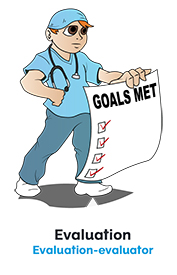
Finally, we evaluate; the “E” in the ADPIE nursing process. Where does this bring us with the computer example?
As the final step, you are done carrying out your plan, and here’s where you are waiting anxiously at the computer store, and the person helping you comes out to tell you, “Well my friend, it’s your lucky day. It was almost too late, but we saved your computer and it works like it’s brand new again. Now, remember, keep liquids far away!” You click the power button and evaluate, did the implementation of the plan achieve the desired outcome? Is the computer turning on? If yes, hooray!
Now with patient care, this would be where you ask yourself as a nurse, were we successful in meeting the desired outcome for the patient? Did the plan work or is it in the process of being successful?
If goals were not met with the health of the patient, we need to reassess and begin the process over, noting why the goals weren’t met, and make changes to the new plan of care for the patient to make sure new goals will be completed, in order to accomplish the health goals of patient care. Essentially, this becomes a cycle.
And, speaking of…while it may have taken some time to read this blog explaining the steps of the nursing process, the process itself is continuous and may be executed very quickly—within seconds or minutes in the case of a trauma or emergency.
Learn ADPIE Faster with Picmonic
Turns out, we’re super fans of techniques and methods used to enhance students’ understanding and ability to remember nursing topics. That’s why we developed this FREE three-minute ADPIE mnemonic video, so you’ll never forget the five steps of ADPIE.
Frequently Asked Questions About ADPIE
What is ADPIE?
ADPIE is the acronym commonly used by nurses (and sometimes other healthcare providers) to remember the five steps in the nursing process: assessment, diagnosis, planning, implementation, and evaluation. The ADPIE process (or nursing process) helps nursing care providers to provide swift, effective, and personalized care for their patients. From the moment you encounter a patient through their care, and as you see them out the door, you’ll implement ADPIE.
What is the purpose of ADPIE?
Before discussing the purpose of ADPIE, it’s important to first understand ADPIE is the acronym used to remember the five steps of — the systematic, rational-based technique for assessing, planning, and providing nursing care to patients. The process begins with identifying the patient’s healthcare status and actual — or potential — health problems and uses this information to establish the patient’s needs and deliver nursing interventions to address these needs.
What is the nursing process? And, why is it used?
The nursing process is potentially the most important assessment and intervention tool in a nurse’s knowledge kit. It’s a well-established, problem-solving technique based on five easy-to-remember steps: assessment, diagnosis, planning, implementation, and evaluation. Through practical application of the nursing processes, nursing care providers can easily determine the healthcare needs of their patients, develop an individualized care plan, swiftly provide patient-centric care, and evaluate the outcomes.
Why is ADPIE Important?
The nursing process is the systematic problem-solving technique used by medical professionals when providing care. ADPIE is the acronym used to remember the five steps of the nursing process: assessment, diagnosis, planning, implementation, and evaluation. ADPIE helps nursing students and nurses themselves remember the five steps of the nursing process, while itself provides a thorough framework for nurses to think critically about the needs of their patients and provide an effective, individualized care plan for ensuring proper patient care.
Download our mobile app and take Picmonic on the go!


Marlee Liberman, RN, Master Nursing Scholar
As a registered nurse, Marlee understands the struggles that nursing school throws at you – not to mention the overwhelming pressure preparing for the NCLEX®! Marlee brings a unique skill set and perspective to Picmonic with her previous degree in broadcast journalism, her creativity in video production, and her wandering nomad lifestyle. Her blend of talents provides her with the knack for simplifying complicated concepts and demystifying the world of nursing.














